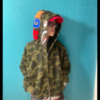The tension between pure art and retail fashion is at the heart of a new lawsuit, filed in California, in which two street artists claimed that the unauthorized use of the BATES and NEKST tags on certain items of clothing sold by defendants harmed the artists’ reputations.
According to the lawsuit, the artists were made to look like “corporate sellouts” who have “traded their artistic independence, legacy, and credibility for a quick buck.”
For street artists, engaged in an alternately celebrated and reviled form of creative expression, any appearance of prioritizing commercial success over artistry presents a perceived threat to credibility.
While hardly the first dispute pitting street artists against corporate behemoths, the case’s emphasis on the artists’ rights of publicity under California Civil Code Section 3344 and related common law is worth a closer look.
In addition to asserting trademark rights, the artists are claiming nonconsensual use on commercial goods of their names and signatures. According to the complaint, naming Guess? Inc. and Macy’s Inc., “in street art, calling out one’s name is often central to the work, as a way for individual members of marginalized groups to claim agency and identity.”
The right of publicity emerged on the fringes of privacy law as cameras and printers became more widely accessible in the late 19th century, with the right to control commercial use of one’s image functioning as a kind of corollary to the right to be left alone.
In Roberson v. Rochester Folding Box, a case before the New York Court of Appeals in 1902, a young woman sued a flour company for using her portrait without her permission.
Today, there’s no federal right of publicity, and state laws surrounding use of a person’s “likeness” vary significantly.
In New York, the law addresses misuse of a person’s name, portrait, or picture and voice, while Indiana law affords special protection to “personalities,” or individuals whose “name, voice, signature, photograph, image, likeness, distinctive appearance, gestures, or mannerisms” have commercial value, whether or not the individuals actively exploit that value. Some state laws protect only residents, while others allow anyone to sue.
Copyright protects original works embodied in tangible form and trademark law serves to promote fair competition by identifying product sources. Publicity rights, meanwhile, arise any time a creative work recognizably captures an individual’s likeness, as defined under applicable law.
A copyright or trademark license from an artist may not be enough for a fashion company seeking to use art on its line of apparel or accessories. If the underlying art features any recognizable individuals or names, determining which laws may apply, analyzing how they define “likeness,” and seeking appropriate consent from the individuals depicted are also relevant considerations.
Also, the law is only one part of the picture. Rights of privacy and publicity are especially sensitive because many people perceive them as close to fundamental human rights, existing in the “penumbra” of explicit constitutional rights. Unauthorized use of an individual’s likeness—whether in the form of a name, voice, photograph, or artistic depiction—may therefore generate adverse publicity, even when technically legal.
For example, in 2013, photographer Arne Svenson opened a show titled “The Neighbors” featuring portraits of New Yorkers whom he had surreptitiously photographed in their homes using a telephoto lens. Several of the subjects sued him for violating their right of publicity by selling postcards of their portraits and intentionally inflicting emotional distress. Svenson prevailed in the legal case based on the fact that his art wasn’t “for advertising or trade purposes” under New York law, but he received significant public criticism.
For fashion brands exploring the use of third-party artwork, rights of publicity may be a key part of preparation, investigation, and analysis.
The case is Patrick Griffin et al v. Guess? Inc., C.D. Cal., No. 2:24-cv-00318, complaint filed 1/12/24.
This article does not necessarily reflect the opinion of Bloomberg Industry Group, Inc., the publisher of Bloomberg Law and Bloomberg Tax, or its owners.
Author Information
Karen Artz Ash is an intellectual property partner at Katten and co-chair of the firm’s trademark, copyright, and privacy group.
Cynthia Martens is an intellectual property attorney at Katten with a focus on trademark and copyright in the fashion and beauty industries.
Write for Us: Author Guidelines
This post was originally published on this site be sure to check out more of their content.






